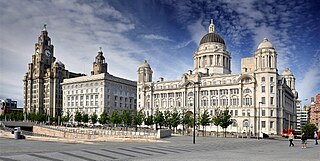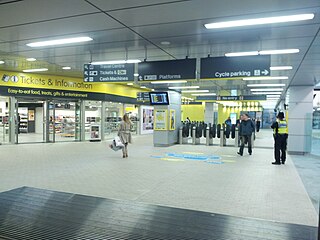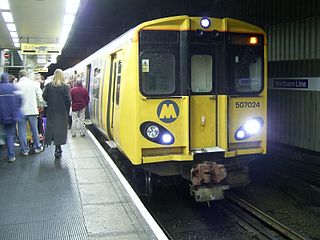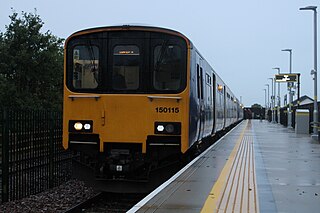
Merseyside is a ceremonial and metropolitan county in North West England. It borders Lancashire to the north, Greater Manchester to the east, Cheshire to the south, the Welsh county of Flintshire across the Dee Estuary to the southwest, and the Irish Sea to the west. The largest settlement is the city of Liverpool.

Merseyrail is a commuter rail network which serves Merseyside and adjacent areas of Cheshire and Lancashire. Merseyrail serves 69 stations, 67 of which it manages, across two lines – the Northern Line and the Wirral Line. The network uses 750 V DC third rail electrified lines having 75.0 miles (120.7 km) of routes, of which 6.5 miles (10.5 km) are underground. Since January 2023, Merseyrail commenced replacing its train fleet, withdrawing the Class 507 and 508 trains and introducing 53 new Class 777 trains. The network carried 25.5 million passengers in the 2022/2023 statistical period.

Croxteth is a suburb of Liverpool, Merseyside, England, and a Liverpool City Council Ward. Although housing in the area is predominantly modern, the suburb has some notable history. At the United Kingdom 2011 Census it had a population of 14,561. Croxteth is within the boundaries of the traditional county Lancashire.
Merseytravel is the passenger transport executive, responsible for the coordination of public transport in the Liverpool City Region in North West England. Merseytravel was established on 1 December 1969 as the Merseyside Passenger Transport Executive. From 1 April 2014, with the creation of the Liverpool City Region, Merseytravel expanded its area of operation from the metropolitan county of Merseyside to also include the Borough of Halton.

Liverpool Central railway station in Liverpool, England, forms a central hub of the Merseyrail network, being on both the Northern Line and the Wirral Line. The station is located underground on two levels, below the site of a former mainline terminus. It is the busiest station in Liverpool, though considerably smaller than Lime Street station, the mainline terminus, and the busiest station to operate solely on the Merseyrail network. The station is the busiest underground station outside London serving 40,000 people daily. The station in passengers per platform is the busiest underground railway station in the United Kingdom outside of London at 3,979,547 per platform per annum and coming tenth out of all stations outside the capital, underground or overground.

Hunts Cross railway station is a Grade II listed railway station in Hunt's Cross, Liverpool, England. It is situated on the southern branch of the City Line (Merseytravel)'s Liverpool to Manchester Line route, and is the southern terminus of Merseyrail's Northern Line.

Liverpool South Parkway station is a railway station and bus interchange in the Garston district of Liverpool, England. It serves, via a bus link, Liverpool John Lennon Airport in the neighbouring suburb of Speke, as well as providing an interchange between main line services and the Merseyrail rapid transit/commuter rail network. Opened in 2006 on the site of the former Allerton railway station, it also replaced the nearby Garston station.

The Northern line is one of two commuter rail routes operated by Merseyrail and centred on Merseyside, England, the other being the Wirral line. The cross-city route runs from Hunts Cross in south Liverpool then branches in the north to terminate at Southport, Headbolt Lane and Ormskirk (Lancashire).

The Wirral line is one of two commuter rail routes operated by Merseyrail and centred on Merseyside, England, the other being the Northern line.
The North Liverpool Extension Line was a railway line in Liverpool, England in operation between 1879 and 1972. It was at one stage intended to become the eastern section of the Merseyrail Outer Loop, an orbital line circling the city.
The Skelmersdale branch was a standard gauge railway (SKE) which connected the Liverpool, Ormskirk and Preston Railway at Ormskirk with Rainford Junction via Skelmersdale. At Rainford it connected with the Liverpool and Bury Railway and the St. Helens Railway. It was built by the East Lancashire Railway, which was taken over by the Lancashire and Yorkshire Railway shortly afterward. The steam railmotor which served the line was sometimes known locally as the "Skem Dodger" and other times as the "Skem Jazzer".

The Liverpool–Wigan line is a railway line in the north-west of England, running between Liverpool Lime Street and Wigan North Western via St Helens Central station. The line is a part of the electrified Merseyrail Liverpool to Wigan City Line. The stations, and all trains serving it, are operated by Northern Trains, however the stations are branded Merseyrail using Merseyrail ticketing.

Kirkby railway station is situated in Kirkby, Merseyside, England. It is situated 7.5 miles (12 km) north-east of Liverpool Central and is on the Headbolt Lane branch of Merseyrail's Northern Line.

Skelmersdale railway station was a station located on the Skelmersdale branch at Skelmersdale, England. The station was originally named Blague Gate, having its name changed to Skelmersdale on 8 August 1874 and carried passengers from 1858 to 1956.

The City Line is the brand name used by Merseytravel on suburban rail services in the Liverpool City Region starting eastwards from the mainline platforms of Liverpool Lime Street railway station.

The Kirkby Branch Line is a branch railway line from Wigan to Headbolt Lane. The line's original route was from Liverpool to Bury and later the most northern of the Liverpool to Manchester lines. The line was split at Kirkby in 1977 with the western section forming a high frequency branch of the electrified Merseyrail Northern Line, also referred to as the Kirkby branch line. The Kirkby branch to Wigan remained a low frequency diesel operated service by Northern Trains from Headbolt Lane to Manchester.

Headbolt Lane is a railway station in Kirkby, Merseyside, England, which opened on 5 October 2023.

Urban andsuburban rail plays a key role in public transport in many of the major cities of the United Kingdom. Urban rail refers to the train service between city centres and suburbs or nearby towns that acts as a main mode of transport for travellers on a daily basis. They consist of several railway lines connecting city centre stations of major cities to suburbs and surrounding towns.
Liverpool in North West England, is a major British city with significant road, rail, and ferry networks, in addition to an international airport and a well-known dock system. As with most other major UK cities, Liverpool's transport infrastructure is centred on its road and rail networks. Public transport services within the city are controlled and run by Merseytravel.


















